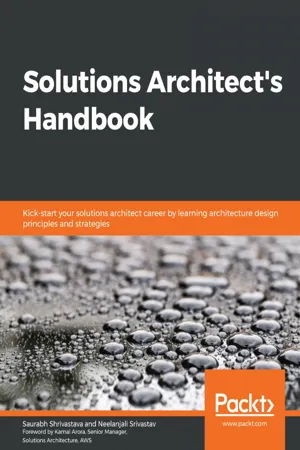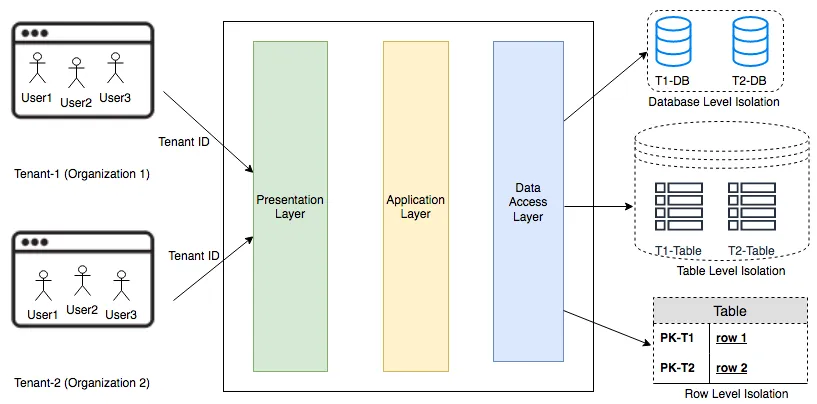
Solutions Architect's Handbook
Kick-start your solutions architect career by learning architecture design principles and strategies
- 490 pages
- English
- ePUB (mobile friendly)
- Available on iOS & Android
Solutions Architect's Handbook
Kick-start your solutions architect career by learning architecture design principles and strategies
About this book
From fundamentals and design patterns to the different strategies for creating secure and reliable architectures in AWS cloud, learn everything you need to become a successful solutions architect
Key Features
- Create solutions and transform business requirements into technical architecture with this practical guide
- Understand various challenges that you might come across while refactoring or modernizing legacy applications
- Delve into security automation, DevOps, and validation of solution architecture
Book Description
Becoming a solutions architect gives you the flexibility to work with cutting-edge technologies and define product strategies. This handbook takes you through the essential concepts, design principles and patterns, architectural considerations, and all the latest technology that you need to know to become a successful solutions architect.This book starts with a quick introduction to the fundamentals of solution architecture design principles and attributes that will assist you in understanding how solution architecture benefits software projects across enterprises. You'll learn what a cloud migration and application modernization framework looks like, and will use microservices, event-driven, cache-based, and serverless patterns to design robust architectures. You'll then explore the main pillars of architecture design, including performance, scalability, cost optimization, security, operational excellence, and DevOps. Additionally, you'll also learn advanced concepts relating to big data, machine learning, and the Internet of Things (IoT). Finally, you'll get to grips with the documentation of architecture design and the soft skills that are necessary to become a better solutions architect.By the end of this book, you'll have learned techniques to create an efficient architecture design that meets your business requirements.
What you will learn
- Explore the various roles of a solutions architect and their involvement in the enterprise landscape
- Approach big data processing, machine learning, and IoT from an architect s perspective and understand how they fit into modern architecture
- Discover different solution architecture patterns such as event-driven and microservice patterns
- Find ways to keep yourself updated with new technologies and enhance your skills
- Modernize legacy applications with the help of cloud integration
- Get to grips with choosing an appropriate strategy to reduce cost
Who this book is for
This book is for software developers, system engineers, DevOps engineers, architects, and team leaders working in the information technology industry who aspire to become solutions architect professionals. A good understanding of the software development process and general programming experience with any language will be useful.
]]>
Frequently asked questions
- Essential is ideal for learners and professionals who enjoy exploring a wide range of subjects. Access the Essential Library with 800,000+ trusted titles and best-sellers across business, personal growth, and the humanities. Includes unlimited reading time and Standard Read Aloud voice.
- Complete: Perfect for advanced learners and researchers needing full, unrestricted access. Unlock 1.4M+ books across hundreds of subjects, including academic and specialized titles. The Complete Plan also includes advanced features like Premium Read Aloud and Research Assistant.
Please note we cannot support devices running on iOS 13 and Android 7 or earlier. Learn more about using the app.
Information
- Building an n-tier layered architecture
- Creating a multi-tenant SaaS-based architecture
- Building stateless and stateful architecture designs
- Understanding service-oriented architecture (SOA)
- Building a serverless architecture
- Creating a microservice architecture
- Building a queue-based architecture
- Creating an event-driven architecture
- Building a cache-based architecture
- Understanding the circuit breaker pattern
- Implementing the bulkheads pattern
- Creating a floating IP pattern
- Deploying an application with a container
- Database handling in application architecture
- Avoiding anti-patterns in solution architecture
Building an n-tier layered architecture

- Web Layer: The web layer is the user-facing part of the application. End users interact with the web layer to collect or provide information.
- Application Layer: The application layer mostly contains business logic and acts upon information received from the web layer.
- Database Layer: All kinds of user data and application data are stored in the database layer.
The web layer
The application layer
The database layer
Creating multi-tenant SaaS-based architecture

- Database Level Isolation: In this model, each tenant has its database associated with its tenant ID. When each tenant queries data from the user interface, they are redirected to their database. This model is required if the customer doesn't want a single shared database for compliance and security reasons.
- Table Level...
Table of contents
- Title Page
- Copyright and Credits
- Dedication
- About Packt
- Foreword
- Contributors
- Preface
- The Meaning of Solution Architecture
- Solution Architects in an Organization
- Attributes of the Solution Architecture
- Principles of Solution Architecture Design
- Cloud Migration and Hybrid Cloud Architecture Design
- Solution Architecture Design Patterns
- Performance Considerations
- Security Considerations
- Architectural Reliability Considerations
- Operational Excellence Considerations
- Cost Considerations
- DevOps and Solution Architecture Framework
- Data Engineering and Machine Learning
- Architecting Legacy Systems
- Solution Architecture Document
- Learning Soft Skills to Become a Better Solution Architect
- Other Books You May Enjoy